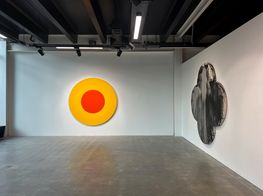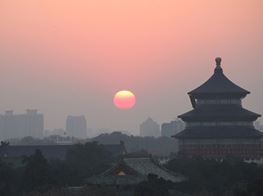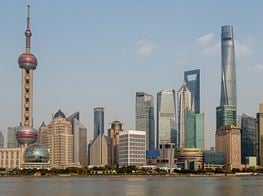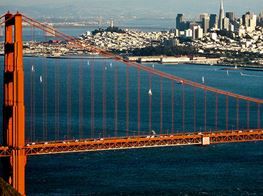Max Gimblett
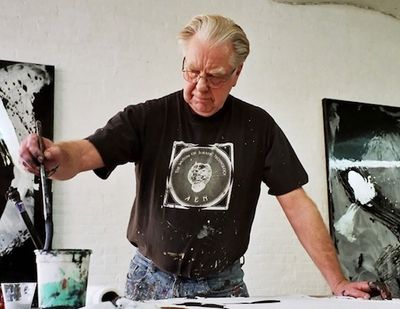
What a strange and wonderful place to meet the painter Max Gimblett – in the hutongs of Beijing. It was as a student of art history in New Zealand that I first came across the work of Max Gimblett. Although the artist has been based in New York since 1972, is now a citizen of America, and has exhibited regularly there (including in the Guggenheim’s exhibition in 2009, The Third Mind: American Artists Contemplate Asia
, 1860-1989), Gimblett is still viewed as one of New Zealand’s most successful living artists.
Gimblett’s large abstract work predominantly consists of geometric shaped canvases - rectangles, quatrefoils and circles - painted in bold, even fluorescent colours, anchored by sometimes delicate or lyrical, and sometimes violent or explosive gestures of paint. In its purity of colour and interrogation of the picture plane, Gimblett’s practice slides neatly into the historical trajectory of Modernism. And it is perhaps Gimblett’s ability to speak to that ‘schism’ while simultaneously exploring a density of associations that span geography, history, art, religion and culture that make the work so intriguing. If the artist’s broad brushstrokes evoke Willem de Kooning, they also speak to his long-term interrogation of Japanese calligraphy. If his use of the quatrefoil breaks with the notion of the canvas as picture window, it equally references Jungian psychology or the Eastern orthodox cross.
When I meet Gimblett in Beijing, he has already had a week in China under the stewardship of John O’Loghlen and Sophia McKinnon – who together run The China Contemporary Art & Architecture Tours. Gimblett is a long time friend of O’Loghlen’s (they were neighbours in the Bowery, New York). Gimblett had joined the tour to explore China for the first time, and I am intrigued to know how this trip will inform his practice. Gimblett’s fascination with Japanese culture is well documented. The artist is ordained a Rinzai Zen Buddhist, and the brush-and-ink drawing and gestures that are characteristic of his work reflect a form of Japanese ink calligraphy, while his process speaks to an Eastern form of meditation.
Over the next five days, McKinnon and O’Loghlen take Gimblett to see some of Beijing and Shanghai’s most important art institutions and places – for example, the Caochangdi district, OCT Contemporary Art Terminal and Ullens Centre for Contemporary Art – where McKinnon previously worked with Philip Tinari. We are also introduced to small, lesser-known venues, and eat exceptional food at hidden gems, while dining with various characters from the Chinese art world – Iona Whittaker, Editor of Randian and Sam Gaskin Editor-in-Chief of Artinfo join on separate occassions. Throughout the experience, I am continually impressed by the curiosity and stamina of Max Gimblett. Provided he has ready access to coffee – something that O’Loghlen and McKinnon are able to deliver on demand – he is endlessly keen to learn and know more about China. In this interview, we have a chance to reflect on his career, discuss the influence of Japan, and his experience in China and the possibilities it presented for his painting.
When you first arrived to live in North America, you trained as a potter, but you then enrolled in drawing classes, and this led you to study painting at the San Francisco Art Institute. What was the impetus for the change from ceramics to painting?
I trained as a studio potter in Toronto, Canada. The change from ceramics to drawing and painting was due to the lack of direct colour available in ceramics - they were coated with a coloured glaze that came out quite different in the firing, some weeks later, normally. I needed direct and instant colour.
I met and married my sweetheart, Barbara Kirshenblatt-Gimblett, in 1964 and Barbara gave me permission to become a painter. She came home from University one day, looked at a conte crayon drawing I had done of myself looking in the mirror and said "YOU ARE A PAINTER". That was that.
No training, no further evidence, a wild shot, right out of left field. But it became true.
Do you think your start as a ceramicist had an influence on the painter you are today?
Yes, definitely, my surface has retained the flatness of ceramics. And my colour and my light - it feels like it has been transformed by fire. My sense of design is two-dimensional even though there is volume and three-dimensionality in the works. Even when there is depth, the work always refers back to the two-dimensional picture plane.
At the time when you were beginning to formulate what type of painter you would be, who were the artists you were particularly inspired by and why?
Picasso - because he is the greatest artist of all. His works come at you, and they are so graphic and of course he can draw like an angel. Fra Angelico - who it was said cried as he painted the light-filled heavens. Jasper Johns for his treatment of all consuming subject matter…there were many others.
Your first solo painting exhibition was at Dave Hickey’s in Austin in 1971?
Well of course Dave Hickey is fully inspired and his gallery was called "A Clean Well Lighted Place" after an Ernest Hemingway short story. Ernest said he learned to write descriptions of landscapes from looking at Cezanne and I say I learnt to paint abstractly reading Ernest Hemingway. He is my top author.
Now if we skip to your most recent works – how different/similar are they to the works you created for the show at Dave Hickey’s?
The paintings I exhibited at Dave Hickey’s are vastly different to the ones I paint today, but share in common high colour, a strong sense of the picture plane, lyrical, wet. There is a much stronger sense of subject. The light is clarified by clean high-pitched colour. The surface is sure of itself. Shape and scale are articulated. I paint four major shapes as varying scales relating to the body, the space in a room and to the furniture.
One of the aspects that make your work so recognizable is your use of the quatrefoil. Perhaps we can talk about when you started to use it and why?
In 1983 the quatrefoil came into my mind as a symbol of wholeness. It is a Mandala. Fresh in all cultures it sets up an image field into which I touch being. It makes my vision stand out from all the thousands and thousands of door/window frame paintings.
The vocabulary of your work appears very rooted in the history of Modernism – and in an interview with Alexandra Munroe, Senior Curator at the Guggenheim, you described yourself as a Modernist. However, you equally acknowledge the importance of spirituality to your practice.
My initial central text for my plastic vision was Kandinsky's THE SPIRITUAL IN ART. In this statement, which he lived out in his paintings, Kandinsky drew a direct parallel between painting and spirituality and values in the community - this was his Modernism. There were no schisms, no splits. His vision has sustained me to this day. I do not see art as pertaining to the market place, but rather creating change conditions for the citizens of our world, all eight billion of us. Art stands for the truth and feeds people with spirit.
I was watching a video of you painting in your studio. There is a sense of theatre to the way you paint. Your entire body appears involved in the work, and you often punctuate your painting process by stopping to clap. Tell me about your process of painting?
My painting process is based on "ALL MIND NO MIND". If you let go of your Mind, you have your Mind. Modern dance comes in here in the process as does athletics and the full body. When I began painting in 1964/65 in Toronto and San Francisco, I used to load the brush with liquid oil paint and charge the canvas screaming. I thought I was painting De Koonings. Later on I was to discover the shouting is an aspect of Zen and of putting the Mind down. The gesture is faster than the Mind can think. The gesture gets ahead of the Mind by generating touch. I think touch comes before words, and before mind activity. Somebody told me this morning that the child, the baby, will elect, will choose, being held over feeding. Being touched and touching is crucial.
Also FIRST THOUGHT BEST THOUGHT and THE LOADED BRUSH TO UNLOADED - all of these are crucial aspects of my process. As I have been painting 50 years now, these aspects are all second nature and inbuilt.
You talk a lot of dualities in relation to your art. In the interview with Alexandra Munroe you talk of your works being both abstract and also figurative – I thought perhaps we could discuss that?
Well my conditions for understanding my painting and all modern paint are image/field and figure/ground. I think it was a journalist that coined the term abstract - a very dangerous term. Jackson Pollock said his painting was figurative most of the time and certainly always in part figurative, so the Clement Greenberg battle about figuration and abstraction is well put to rest now. One paints in images, the Mind works with images - images describe what we see and experience, surely?
Your work has been very inspired by Japanese ink. Can you explain the moment when you first realized it was going to change your direction as a painter?
It was in San Francisco in 1966 that I came under the influence of Kenneth Patchen, the poet and ink drawer who did Zen inks. I just loved his vision. Then a few years later in Bloomington, I realized my works were no longer coming from Matisse, in my ink drawings, but from Japanese Zenga. I quickly was smart enough to adopt some of the leading Japanese Masters alive and dead, mostly released from their bodies, as my teachers. I called on them and they visited me, they were humble and only out to help me and love me. They welcomed me into their tradition wholeheartedly and seemed pleased a westerner was interested.
They were and remain Sengai Gibon, Tesshu the No Sword Warrior, Hakuin and Nobutada. There are of course others.
We recently travelled in China together with John O’Loghlen and Sophia McKinnon. I know you were particularly interested in Chinese ink. Sophia took us to see this very interesting dealer and in a drawer hidden away you discovered ink works by a particular artist that you felt very inspired and excited by. Do you remember that?
Oh yes, I am still digesting his influence. I live with his catalogue that dealer gifted me. I was absolutely captivated with his drawings, they are so entirely modern and yet from a long, deep tradition. He is Bian Pingshan. He is a Master. The Chinese are so inside their black ink tradition that they are free to improvise and hence speak. My ink drawing is Zenga - a meeting place of Abstract Impressionism and Japanese calligraphy, so the Chinese manner is a long way away from me, but slowly, slowly I edge closer. There is hope!
Were there other artworks or experiences on that trip that were particularly memorable or significant for you?
I was aware of how warm and intimate the Chinese staff were in my Hotel, The East in Beijing - how free they were with their love and attention and warmth, their giving was total. I went to the main Museums and was captivated by the Jade galleries. I spent one entire day in the Jade rooms.
I was very struck by the expatriate tradition - the Anglos in China banding together and yet speaking excellent Chinese and their deep love of China. It was uplifting.
I have known John O'Loghlen since he was a child; I went to school with his father, played on the same rugby team. It is lovely to know John as a successful businessman, a loving husband and new father and a deep, deep lover of China. And I, like everybody else who has met her, fell in love with Sophia McKinnon. What Sophia does not know about China is not worth knowing. Sophia is a natural force.
Xiaoming Zhang represents me and my work in China. She’s a distinguished, inspired, and a brilliant art dealer. I am 78 and in China was treated with respect and had constant hands on, helping me in and out of cars, etc. and it was delicious, to be so well treated.
Has your experience in China had an influence on your painting?
Yes, it has made me feel closer to Emily Cheng my Chinese/American fellow painter who has a spiritual vision. I am drawing closer to China and to her.
When can we next see a Max Gimblett show?
I travel to Florence and Rome in early May to make a limited edition artist's book, etchings, with Ida Panicelli. I show on May 27 with Gow Langsford Gallery in Auckland; June 17 I open with the Nadene Milne Gallery in Arrowtown; and the week of June 9/13 I am a visiting artist at Waikato University in Hamilton, having a one person show of works on paper, and leading Sumi Ink workshops.

